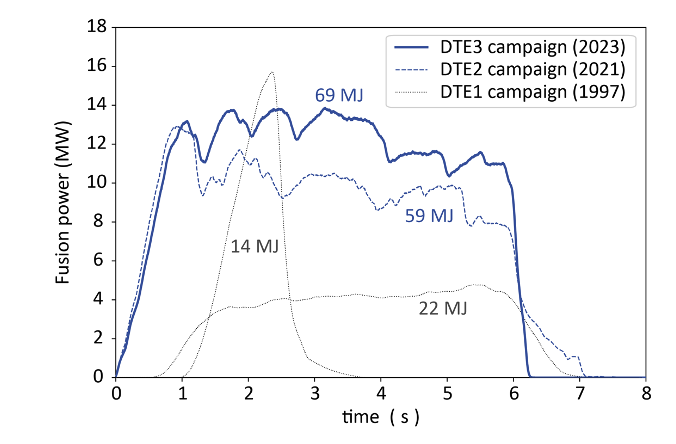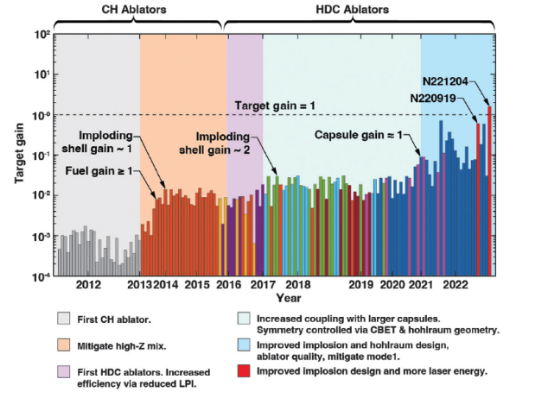By Dr John Carr
A press release was issued on 8 February 2024 entitled “Fusion research facility JET’s final tritium experiments yield new energy record” authored jointly by EUROfusion and UKAEA. The story describes the final results from the Joint European Torus (JET) fusion tokamak which stated operation in 1983 and finished operations at the end of 2023. The highlights of the 40 years of JET operations are the successful experiments with actual fusion reactions. Most of the machine experiments were concerned with advancing knowledge of the plasma physics needed to build a future commercial fusion reactor.

Performance of JET over its lifetime. Fusion power output in tokamak in four experiments with deuterium-tritium fuel in 1997, 2021 and 2023.
The figure shows the fusion power output in four experiments with fusion reactions in deuterium-tritium fuel. The run in 2023 had a total fusion energy of 69 MJ, which is the amount of energy required to boil 26 litres of water from room temperature.
In January 2024 a paper: “Achievement of Target Gain Larger than Unity in an Inertial Fusion Experiment” , was published describing experiments at the National Ignition Facility in the USA with the different fusion technique of laser implosion. The figure below shows the target gain ( = fusion energy out / energy into target) as a function of time from 2011 to 2022, showing that in December 2022 an experiment achieved a target gain > 1. For this experiment, the energy into the target was 2.1 MJ and the energy out was 3.1 MJ, hence an energy gain of 1 MJ ( the energy needed to boil 0.4 litres of water).

Performance of NIF laser implosion experiments between 2011 and 2022 showing target gain ( = fusion energy out / laser energy in).
The JET result ought to be put into perspective by comparing to other fusion projects, of which NIF is the most advanced. The 2023 JET fusion energy output of 69 MJ was clearly higher than the NIF result of 3.1 MJ, so JET has the World Record of total energy produced in a fusion device. However, the NIF result represents the achievement of net energy gain in a fusion device for the first time. The JET press release does not talk of fusion energy gain in the plasma, but from other sources it can be gleaned that the ratio of energy out / energy in was about 0.3, hence a long way from a net gain. So, while the JET result was certainly an advance, the NIF result was a milestone.
The ultimate objective of these two axes two of fusion research is to generate electricity and in the mainstream path to fusion, of which JET was a step, the goal has been a commercial power plant with electricity output of 1 GW. With the JET result, converted to an average fusion power over a year of 2.2 W, in order to produce such a power plant would require the performance to increase by more than a factor of one billion in subsequent development steps.
Although JET has made great advances in its 40 years of operations, the path to a 1 GW power plant is at best several decades in the future.